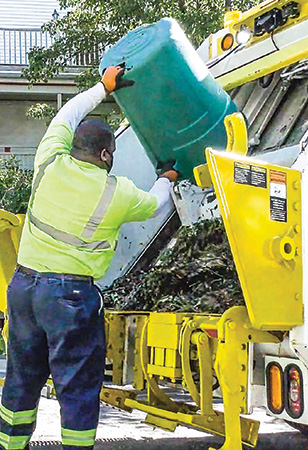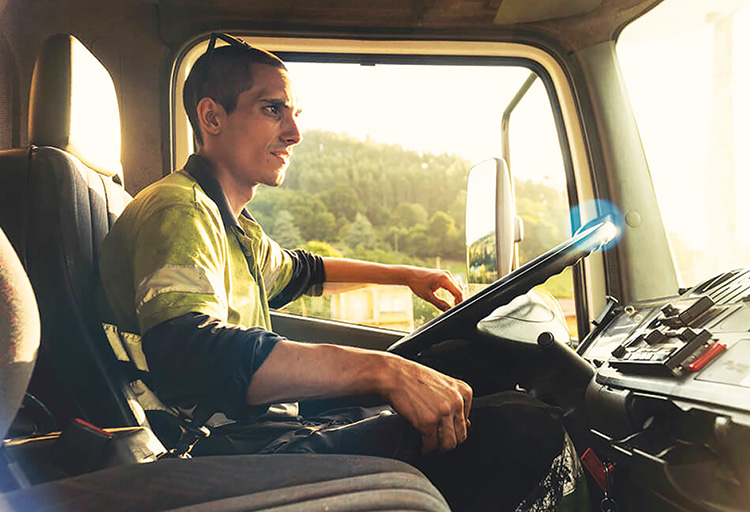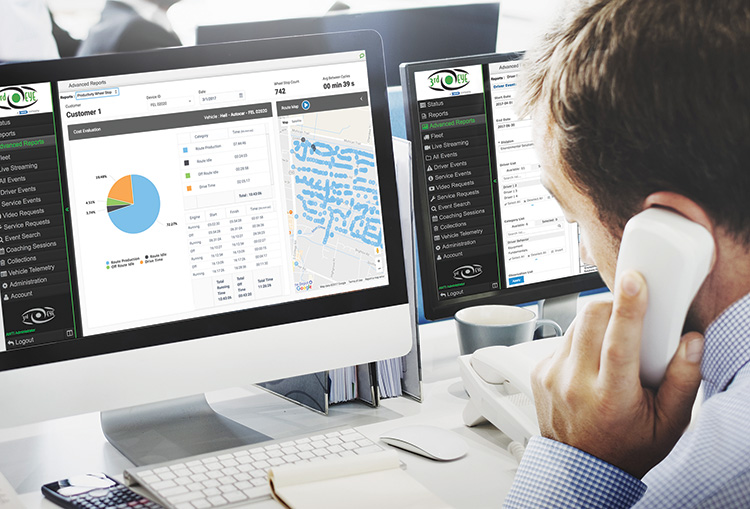Despite the numerous COVID-related challenges that continue to face the waste industry, haulers have numerous options to increase their productivity and minimize the impact of labor shortages, without requiring additional employees. Innovative technology solutions have improved the lives of haulers and individual fleet needs.
Like all businesses nationwide, the waste industry has experienced unprecedented COVID-related challenges since the epidemic first entered the world stage in 2020. Although waste collection services were allowed to remain in operation through classification as an essential industry, both private and municipal waste collection fleets have faced issues that even the most forward-thinking planners could never have anticipated.
To compound matters for the refuse industry, massive company shutdowns resulted in a dramatic increase in the public being confined to their homes. As a result, the volume of residential waste increased exponentially as home-bound residents discarded more trash and used the time off to perform major house cleaning activities. With an already reduced labor force and significant increase in residential waste being left at the curb, a “perfect storm” of challenges were created for an already-overwhelmed industry.
News of vaccination developments and pandemic decline gradually provided a glimmer of hope that the waste industry was finally on a path back to normalcy. Much to their dismay, the “post-COVID” labor phenomenon would pose an even greater challenge than the initial pandemic.

Although hiring rates have outpaced “quit rates”, what has become known as “The Great Resignation” or “The Great Reshuffle” has had significant impact on staffing levels in the waste industry. A complex and controversial topic, there are countless resources available that address this phenomenon. Like most challenges outside of one’s ability to control, the adage “You can’t change the wind, but you can adjust the sails” provides a much healthier and productive approach to dealing with the current labor crisis.
As one of the nation’s most resilient industries, the solid waste sector is no stranger to change and has a long history of evolving to thrive during unprecedented challenges. Rather than dwelling on the problem, successful haulers have quickly embraced the opportunities that exist, enabling them to remain productive and profitable, while those who do things the way that they have always been done continue to struggle.
Now, there is the critical need for real-world solutions that allow waste haulers to operate at peak efficiency and profitability. Cutting-edge technology and equipment solutions maximize productivity, increase safety, improve operator satisfaction/retention, reduce stress, and deliver healthier bottom lines. The objective of this article is to identify ways that successful waste organizations have adapted, enabling them to do more with less
Using Technology to Maximize Efficiency with Fewer Employees
A comprehensive fleet data strategy provides a rich stream of data and data-driven options that improve operator performance, maximize efficiency, and automate the communication of information between the vehicle and back office/service shops. Most importantly, functions can be performed passively and eliminate the need for manual actions by drivers, office staff, or shop personnel. The following are a few of the top time and labor-saving technology solutions to increase efficiency, productivity, and profitability with fewer employees.
Routing Efficiency
Planning waste hauling routes can be a time-consuming and complex logistical challenge with countless factors requiring on-the-fly adjustments and communication to operators on the street. Performing this task manually often requires a full-time team to accomplish, while standard routing software is not designed for the complicated factors involved with waste hauling routes.
Mapping software provides intelligent turn-by-turn route guidance—real-time productivity status, and real-time communication between dispatch and the operator for immediate workload revisions via the in-cab tablet. Routing solutions provide the most efficient and flexible turn-by-turn mapping tools, while saving countless hours of wasted labor by office and operator personnel.

Safety/Coaching
With fleets struggling to hire additional drivers and to retain existing operators, keeping drivers safe, well trained, and empowered is now more important than ever. The waste industry’s most advanced fleets have discovered that technology can easily provide the information needed to develop highly successful safety and driver coaching programs that increase driver safety and retention, reduce liability, reduce labor shortages from injured or suspended drivers, and maximize productivity. Safety videos can capture incidents in real time to identify unsafe behavior, and to provide fleet owners with a complete overview of what the driver sees, and what they do not see. Video findings provide invaluable input that can be used for positive coaching events, as well as post-accident fault mitigation. By becoming aware that activity is being monitored, and with reinforcement of a coaching program, positive driver behavior is dramatically increased, resulting in safer fleets, fewer liability incidents, and additional, better trained operators available for the route.
Positive Service Verification
Anyone within earshot of a waste fleet receptionist is all too aware of the regular stream of phone calls from irate collection customers complaining that their trash was not picked up and demanding immediate service. For years, fleets have struggled with these complaints, leaving them with the costly choices of dispatching a second truck to service the account, or face potentially losing the customer, often resulting in harsh negative reviews that can have a devastating impact on future business. For haulers with municipal contracts, multiple complaints can even lead to the loss of lucrative city or township accounts. In addition to the stress and potential loss of business from missed pickup complaints, the labor required to dispatch single trucks for individual service calls is incredibly costly, particularly for fleets without sufficient drivers to service even standard routes.
As most missed pickups are a result of blocked, improperly placed, or “not-out” containers, dealing with service complaint calls is a source of great frustration to waste hauling fleets. Early attempts at solving the missed pickup complaint issue required drivers to manually get out of the truck and take photos with a mobile phone or tablet to document the reason why a service could not be completed. Although this method provided basic documentation of missed pickup cause, it required significant time for a driver to manually exit the vehicle, pull out a phone or tablet, take a photo, and send to office staff. Fortunately, service verification technology provides haulers with a powerful solution that instantly eliminates costly go-backs and dramatically improves customer communication and satisfaction. Today’s solutions can provide fleets with a single consolidated record of each stop, all without requiring manual action from the driver—readily accessible in the simple, easy to understand dashboard. Detailed photo or video documentation, including time stamp and GPS coordinates, and all associated details of the service are all right at a fleet’s fingertips.

Increase Fleet Uptime that Reduces Shop Labor and Personnel
Garbage truck maintenance is challenged by several factors that impact overall business performance—starting with the number of vehicles modern fleets must manage, and the reduced number of shop employees available to accomplish this task. With shortages of shop personnel and supply chain constraints affecting new vehicle deliveries, keeping trucks in peak operating condition with existing staff is more critical now than ever to ensure a successful operation.
While vehicle and body technologies have grown dramatically over the last decade, the means to collect data from refuse collections vehicle has lagged, often resulting in reactive maintenance campaigns that only tackle repairs after vehicles are out of service, or down on route. This, in turn, impacts fleet productivity and customer service and, ultimately, leads to the need for an increased number of shop staff and spare vehicles, both of which are simply not an option for most fleets struggling with post-COVID challenges.
Fortunately, a quantum leap forward in technology gives haulers the ability to see the future of their fleet’s maintenance needs. This innovative technology provides a cost-effective means to passively collect data from refuse collection vehicles, providing solutions that specifically address these challenges—reducing labor costs, increasing performance, minimizing the need for spares, improving relationships with customers, and growing bottom lines. Technology passively monitors vehicle performance and automatically detects vehicle maintenance issues before they become a problem, including the engine, brakes, coolant, both diesel and CNG fuel systems, electrical systems, and exhaust, not to mention how weather impacts the vehicle’s performance. Having a detailed diagnosis of each vehicle on this granular level reduces errant parts inventories and, ultimately, reduces the need for additional mechanics and fleet spares to compensate for unanticipated breakdowns.
Where to Go from Here
Despite the numerous COVID-related challenges that continue to face the waste industry, haulers have numerous options to increase their productivity and minimize the impact of labor shortages, without requiring additional employees. Innovative technology solutions have improved the lives of haulers and individual fleet needs. | WA
Environmental Solutions Group is committed to improving the lives of their customers and provides a host of innovative technology solutions through their Connected Collections® offerings. For more information on Connected Collections, visit www.doveresg.com/connected-collections/.
